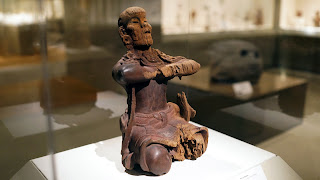https://smarthistory.org/aksumite-coins/
Coins are uniquely significant and give us a greater insight into the history of Aksum. These coins are said to be significant not only because they provided evidence of a form of currency in Aksum but also because they depicted its rulers. The way these coins were inscribed has given us insight into the fact that Aksumites were both knowledgeable and literate people.
Early indicators suggested the main use of these coins was for trade internationally. The earliest coins were struck in gold and silver and followed weight standards established by the Roman Empire. These coins represented King Endybis (c. 270-290 C.E.) and symbols such as the crescent and disc were said to represent the religion of southern Arabia, to which Aksuma was accustomed to.
 |
Aksumite gold coin. Bust represents King Endubis, triangular ribbon behind, wrapped in wheat.
King Ezana took power in 340 C.E and brought along Christianity to the people of Africa. The king made a statement of replacing previous existing religious symbols with with a cross. This was a clear symbol of the importance that Christianity now had in this kingdom. As time progressed, more and more copper coins were introduced into circulation, these coins were evidently Christian, having messages such as "He conquers through Christ". As copper coins continued to replace tradional gold and silver, the craftsmen of Aksum were able to employ new, specialized techniques such as guilding. This would allow for greater details, which enhanced appearance and usually increased the value.
Coin of King Joel, represented by a cross and more modern, detailed, symbols. |




Hi Jeremy! It seems like we both did stuff surrounding the Kingdom of Axum! Neat! (I know some translations say Axum, others Aksum, I'm sticking with Axum though). It's so interesting that you can tell how cultural values shift from what is on the coin. The kingdom was known for its farming and trading of farmed goods, so the wheat being on the coin is symbolic. The shift of the wheat to the cross shows how easily the culture changed under the guidance of a new king. Great post!
ReplyDeleteHello Jeremy!
ReplyDeleteThis was a really cool blog to read about the Aksum culture and some of their pieces of work! One thing that worked well for your post is that you chose to write about a topic that not everyone in our class already wrote about. I did not know that the Aksum society had their own form of currency that had been discovered. This shows a huge significance and tells us a lot about the Aksum people and debunks some of the more ignorant and racist ideologies that Dr. Zimmerman warned us about. These people were artistic, literate and even had their own form of currency for the value of international trade.
-Autumn Fink